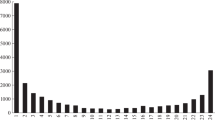Abstract
Regular timing observations of the millisecond pulsar PSR 1937+21 at a frequency of 610 MHz by means of the TNA-1500 radio telescope with a fully steerable 64-m antenna have begun at the Bear Lakes Radio Observatory of the Special Research Bureau of the Moscow Power Engineering Institute. A 40-channel spectrum analyzer and a system for high-speed recording and acquisition of observation data are connected to a reference clock by means of CAMAC interfaces and an 80286 control computer. The reception band is 1.6 MHz (40 channels of 40 kHz each). The total noise temperature of the system is on the order of 160 K. The signal-to-noise ratio is on the order of 50 for a 30-min observation of the pulsar. The mean-square error of measurement of the pulse arrival time is 400 nsec. Data on pulsar 1937+21 along with timing results for “normal” reference pulsars PSR 0834+06 and PSR 1919+21 obtained at the Pushino Radio Observatory of the Lebedev Physics Institute over a period of 13 years will be used to construct a pulsar time scale.
Similar content being viewed by others
References
V. G. Il'in, Yu. P. Ilyasov, Yu. D. Ivanova, et al., A Method for the Creation and Storage of Time Intervals [in Russian], Inventor's Certificate No. 995062 from October 8, 1982, with priority of September 17, 1979, Published February 7, 1983, Bulletin No. 5.
T. V. Shabanova, V. G. Il'in, Yu. P. Ilyasov, et al., “A study of the stability of pulsar radio-emission periods,” Izmer. Tekh., No. 10, 73–74 (1979).
D. C. Backer, S. Kulkarni, C. Heiles, et al., “Millisecond pulsar,” Nature,300, 615–618 (1982).
L. A. Rawley, J. H. Taylor, M. M. Davis, et al., “Millisecond pulsar PSR 1973+21: a highly stable clock,” Science,238, 761 (1987).
V. G. Il'yn (Il'in), L. K. Isaev, S. B. Pushkin, et al., “Pulsar time scale—PT,” Metrologya,22, 65–67 (1986).
B. Guinot and G. Petit, “Atomic time and the rotation of pulsars,” Astron. Astrophys.,248, 292–296 (1991).
A. S. Vdovin, Yu. P. Ilyasov, V. V. Oreshko, and Yu. A. Fedorov, “Time service for introduction of pulsar scale at the Radio Observatory of the Lebedev Physics Institute,” In: Research in Time and Frequency Measurement [in Russian], Gosstandart, Moscow (1989), pp. 4658.
Yu. P. Ilyasov, A. D. Kuz'min, T. V. Shabanova, and Yu. P. Shitov, “The pulsar time scale,” In: Pulsars [in Russian], Nauka, Moscow (1989), pp. 149–159 (Tr. FIAN, Vol. 199).
M. M. Davis, J. H. Taylov, J. M. Weisberg, et al., “High-precision timing observations of the millisecond pulsar PSR 1937+21,” Nature,315, 547–550 (1985).
A. F. Bogomolov, B. A. Poperechenko, A. G. Sokolov, et al., “The fully steerable TNA-1500 radio telescope with 64-m parabolic reflector,” In: Antennas [in Russian, A. A. Pistol'kors (ed.)], Issue 30 (1982), pp. 3–13.
H. S. Kildal and S. A. Skyttemyr, “Dipole-disk antenna with beam-forming ring,” IEEE Trans.,AP-30, 529–534 (1982).
O. V. Doroshenko and S. M. Kopeikin, “An algorithm for precision phase analysis of observations of single pulsars,” Astron. Zh.,67, 986–997 (1990).
Additional information
Scientific-Research Radio-Physics Institute. Translated from Izvestiya Vysshikh Uchebnykh Zavedenii, Radiofizika, Vol. 37, No. 11, pp. 1388–1398, November, 1994.
Rights and permissions
About this article
Cite this article
Belov, Y.I., Ilyasov, Y.P., Poperechenko, B.A. et al. First results of millisecond pulsar 1937+21 timing by TNA-1500 radio telescope of Special Research Bureau of Moscow Power Engineering Institute. Radiophys Quantum Electron 37, 898–904 (1994). https://doi.org/10.1007/BF01057278
Received:
Issue Date:
DOI: https://doi.org/10.1007/BF01057278



